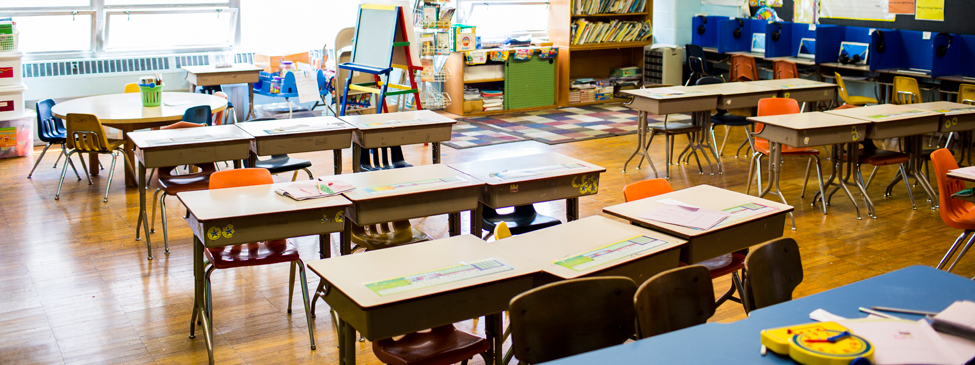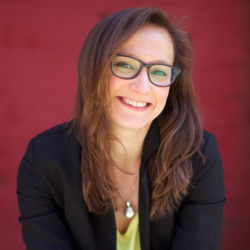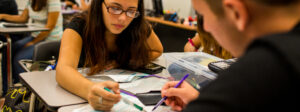That history repeats itself is not lost on Shatavia Knight, 18, a student in Art Worrell’s AP U.S. History course at North Star College Prep in Newark, New Jersey.
“A lot of the things we talk about within this current time period happened as a result of things that happened in history,” she says. “We already know about racism, so now we need to know about the Civil Rights Movement, the Black Panthers. When you know history, you know why things are the way they are today.”
Shatavia is one of Mr. Worrell’s historians in the making—or perhaps more accurately, one of his future makers of history. In this classroom, history is viewed as lens through which to understand the present. Mr. Worrell’s goal—besides that his students are prepared for college success—is to give them “the tools to become a critical thinker, to be socially aware, to have a certain level of consciousness about themselves, their own identity, this country, its history, the way it is, and what it could be.”
We’re in Newark to see how Mr. Worrell accomplishes this—and in the process, learn some history ourselves. Today, Shatavia and her classmates are starting a new unit on the 1970s. The entire class period centers on one key text that will kick off the unit and anchor their discussions: Nixon’s acceptance speech for the Republican presidential nomination in 1968. Mr. Worrell has asked them what they can garner from the speech about Nixon’s vision for America.
As students dig into this new text, there’s a palpable energy in the room. In conversation students fire off connections between the content in front of them and other time periods, works of literature, and current events.
That kind of contextualization is at the heart of the expectations for the AP exam, which Mr. Worrell’s students will take in May, as well as the social studies standards that are embedded in the Common Core literacy standards for grades 6-12. Working in tandem with the ELA standards to ensure that students graduate college and career ready, the literacy standards for history and social studies ask that students be able to do things like analyze primary and secondary sources (and note discrepancies between them); integrate diverse sources of information; and evaluate an author’s premise or arguments and corroborate or challenge them using evidence from other sources. In other words, the basics of being not just historians, but also successful college students—and thoughtful, productive adults.
All of that—and more—is on display in this room. Part of the beauty of watching the class approach Nixon’s speech is the students seem empowered to take educated guesses, to make hypotheses based on what they’re reading, and then revise those as they get more information. There’s no shame in positing an idea that conflicts with a classmate’s, or changing your own mind.
On the contrary, that’s exactly what they’re supposed to be doing. Mr. Worrell starts each new unit with a central text and a question. After they’ve formed a hypothesis, he’ll give them a short lecture—what most of us think of as the centerpiece of high school history. In this classroom, it’s only a small part of the process. Then the students will return to their assumptions and reconsider their ideas.
Now, Shatavia points to a paragraph in which Nixon speaks of the courts “weakening the peace forces as against the criminal forces of this country.”
“I think maybe he’s referring to the Warren Court,” Shatavia says to her group. “Because you know, they gave more rights to the accused. I could be wrong, but that’s what I think.”
“Yeah,” Michelle concurs. “Definitely. He talks about Supreme Court rulings. I just don’t know how he’s going to go and reverse those.”
The group turns to Nixon’s comments on private enterprise. Michelle taps her pen on the table. “He says, ‘Instead of government jobs and government housing and government welfare, let government use its tax and credit policies to enlist in this battle the greatest engine of progress ever developed in the history of man—American private enterprise.’ So what does that mean?” she asks the group.
Mr. Worrell pauses at their table. “So in terms of policy, what’s he calling for?”
Shatavia considers the text. “Investing in these businesses.”
Michelle chimes in. “And less regulation on big businesses.”
“Okay. And where have we seen that before?”
“Laissez-faire,” Michelle suggests.
“The 1920s,” Shatavia adds.
Mr. Worrell moves on, satisfied that his historians are putting together the pieces they’ll need to understand what happens next. The girls continue their discussion.




